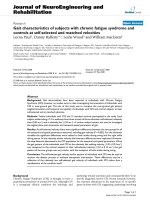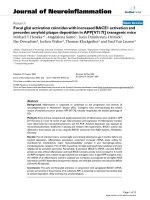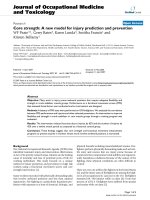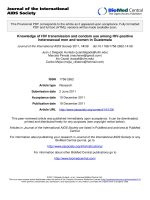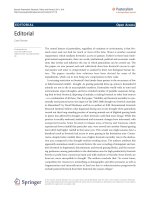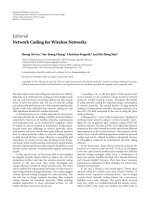báo cáo hóa học:" Editorial Multiuser MIMO Transmission with Limited Feedback, Cooperation, and Coordination" ppt
Bạn đang xem bản rút gọn của tài liệu. Xem và tải ngay bản đầy đủ của tài liệu tại đây (424.9 KB, 2 trang )
Hindawi Publishing Corporation
EURASIP Journal on Advances in Signal Processing
Volume 2009, Article ID 480179, 2 pages
doi:10.1155/2009/480179
Editorial
Multiuser MIMO Transmission with Limited Feedback,
Cooperation, and Coordination
Markus Rupp (EURASIP Member),
1
Ana P
´
erez-Neira (EURASIP Member),
2
Robert W. Heath Jr.,
3
Nihar Jindal,
4
and Christoph Mecklenbr
¨
auker (EURASIP Member)
1
1
Institute of Communications and Radio-Frequency Engineering (INTHFT), Vienna University of Technology,
Gusshausstr. 25/389, 1040 Wien, 1040 Vienna, Austria
2
Technical University of Catalonia, c/Jordi Girona 1-3, 08034 B arcelona, Spain
3
The University of Texas at Austin, University Sta C0803, Austin, TX 78712-0240, USA
4
University of Minnesota, 200 Union St. SE, Minneapolis, MN 55455, USA
Correspondence should be addressed to Markus Rupp,
Received 12 November 2009; Accepted 12 November 2009
Copyright © 2009 Markus Rupp et al. This is an open access article distributed under the Creative Commons Attribution License,
which permits unrestricted use, distribution, and reproduction in any medium, provided the original work is properly cited.
Wireless communication systems are already exploiting pow-
erful multiple antenna technologies based on the principles
of multiple input multiple output (MIMO) communication.
By now, the principles of single user MIMO communication
links are well understood. The next generation of systems,
though, will use more advanced MIMO communication
strategies that support multiuser MIMO. In this way, the
spatial degrees of freedom can be better exploited by properly
scheduling multiple users. However, multiple user commu-
nication with MIMO is more challenging than single user
MIMO because channel state information at the transmitter
is crucial to enhance the system capacity and also due to
the additional degrees of freedom entailed by suppressing,
cancelling, or avoiding interference. For example, limited
feedback algor ithms that are used to quantize channel state
information at the receiver and send this information back
to the transmitter(s) or relay(s) become more complex,
since they need much higher resolution to achieve similar
performance as their single-user counterparts. Consequently,
advances in limited feedback communication are still
required to make multiuser MIMO viable in next-generation
systems.
Although using multiuser MIMO within individual
cells has considerable potential, even larger performance
gains can be achieved by using multiuser MIMO across
cooperative base stations. In the ideal case with perfect
cooperation across all cells, the set of all base station antennas
can be thought of as a single, distributed antenna array.
Significant gains can also be achieved by some level of local
coordination, for example, neighboring base stations might
jointly choose beamforming directions in order to achieve
interference alignment. In this general setting, there are
fundamental challenges associated with t ransceiver design,
limited channel information, and cooperative mechanisms.
For this special issue we received 23 submissions of which
we accepted nine. All papers were peer reviewed by multiple
reviewers. We summarize the papers accepted for the special
issueasfollows.
The article entitled “Space-frequency block code with
matched rotation for MIMO-OFDM system with limited
feedback” by M. Zhang et al. presents a novel matched
rotation precoding (MRP) scheme to design a rate one space-
frequency block code (SFBC) and a multirate SFBC for
MIMO-OFDM systems with limited feedback. The proposed
rate one MRP and multirate MRP can always achieve
full transmit diversity and optimal system performance
for arbitrary number of antennas, subcarrier intervals,
and subcarrier groupings, with limited channel knowledge
required by the transmit antennas. Simulations show that the
proposed SFBC with MRP can overcome the diversity loss
for specific propagation scenarios, always improve the system
performance, and thus demonstrate flexibility and feasibility
making it suitable for a practical MIMO-OFDM system with
dynamic parameters.
The article entitled “On the asy mptotic optimality of
opportunistic nor m-based user selection with hard SINR
2 EURASIP Journal on Advances in Signal Processing
constraint” by X. Zhang et al. studies the optimality of
the opportunistic norm-based user selection system in
conjunction with hard SINR requirements under max-min
fair beamforming transmit power minimization. It is shown
that not only as the number of transmitting antennas goes to
infinity but also when a limited number of transmit antennas
and/or median range of users are available, only insignificant
performance degradation is observed with respect to the
optimum in simulations with an ideal channel model or
based on measurement data.
The article entitled “Mode switching for multi-antenna
broadcast channel based on delay and channel quantiza-
tion” by J. Zhang et al. considers the degradation of the
performance of multiple-input multiple-output (MIMO)
communications by imperfect channel state information and
shows that its effect on single-user (SU) and multiuser (MU)
MIMO transmissions is quite different. In particular, MU-
MIMO suffers from residual interuser interference due to
imperfect channel state information while SU-MIMO only
suffers from a power loss. This paper compares the through-
put loss of both SU and MU-MIMO in the broadcast channel
due to delay and channel quantization. Accurate closed-form
approximations are derived for achievable rates for both SU
and MU-MIMO. Based on derived achievable rates, a mode
switching algorithm is proposed, which switches between SU
and MU-MIMO modes to improve the spectral efficiency
based on average signal-to-noise ratio (SNR), normalized
Doppler frequency, and the channel quantization codebook
size. The operating regions for SU and MU modes with
different delays and codebook sizes are determined, and they
can be used to select the preferred mode.
Limited feedback enables the practical use of channel
state information in multiuser multiple-input multiple-
output (MIMO) wireless communication systems. Unfortu-
nately, when codebooks are used to quantize the channel
state, achieving the high resolution required with multiuser
MIMO communication is challenging due to the large
number of codebook entries required. The article entitled
“Progressive refinement of beamforming vectors for high
resolution limited feedback” by R. W. Heath et al. proposes
to use a progressively scaled local codebook to enable high
resolution quantization and reconstruction for multiuser
MIMO with zero-forcing precoding. New local Grassman-
nian codebook designs are provided along with several new
algorithms for implementing the progressive quantization
with low complexity.
The article entitled “Limited feedback multiuser MIMO
techniques for time-correlated channels” by E. Zacarias et
al. studies limited feedback for single-user and multiuser
MIMO transmission. In the first half of the paper, the
role of limited feedback for single-user MIMO systems in
the presence of strong interfering signals is investigated. In
this setting the optimal transmit strategy depends on the
channel as well as the spatial structure of the interference,
and methods for feeding back such information are proposed
and analyzed. In the second half of the paper, a partial
feedback mechanism for multiuser MIMO systems with
time correlated channels is proposed. The proposed method
tracks each entry of the channel matrix using single-bit
quantization, and fur ther limits the feedback rate by feeding
back information for only a few of the channel entries during
each feedback slot.
The article entitled “Effects of mutual coupling and noise
correlation on downlink coordinated beamforming with
limited feedback” by Y. Dong et al. considers the impact of
receiver correlation, antenna coupling, matching, and noise
on the performance of coordinated beamforming systems. A
novel coordinated beamforming technique for two receivers
is presented, suitable for MIMO broadcast channels with
signal and noise correlation at the receiver end. Numerical
results suggest that, even in the presence of strong coupling,
most of the benefits of coordinated beamforming can be
preserved by using appropriate matching networks and linear
beamforming. Such benefits can be achieved even with
limited feedback.
Ubaidulla and Chockalingam contr ibute the article enti-
tled “Robust THP transceiver designs for multiuser MIMO
downlink with imperfect CSIT” which discusses Tomlinsson-
Harashima precoding based on two different models for the
uncertainty in channel state information at the transmitter
(CSIT). The first model assumes that the CSIT error is
Gaussian-distributed; whereas the second model bounds
the norm which results in an uncertainty set. The authors
propose iterative algorithms involving semi-denite programs
(SDPs). Final ly they show that the proposed robust designs
outperform nonrobust designs as well as robust linear
transceiver designs reported in the recent literature.
The article entitled “Downlink multicell processing w ith
limited backhaul capacity,” by O. Simeone et al. discusses
performance limits in linear cellular system using the Wyner
model with base station coordination. The authors derive
achievable rates for different transmission configurations
that require varying degrees of side information and thus
have different backhaul capacity requirements. They show
that side information in the form of codebook information
is required for achieving high data rates, while multicell
processing with no codebook side information provides
adequate performance for low data rate targets.
The article entitled “A WiMAX-based implemenation
of network MIMO for indoor wireless systems” by S.
Venkatesan et al. establishes the performance that can be
achieved in indoor networks using network MIMO, or base
station coordination. They quantify the gains in spectral
efficiency under realistic indoor propagation conditions
through comprehensive simulations within the framework of
IEEE 802.16e Mobile WiMAX standard. A major outcome
of the paper is to show that with sufficient backhaul
connections between the base stations, multifold increases in
spectral efficiency are achieved using network MIMO. This
confirms that multicell coordination is one viable solution to
improving capacity in cellular sytems.
Markus Rupp
Ana P
´
erez-Neira
Robert W. Heath Jr.
Nihar Jindal
Christoph Mecklenbr
¨
auker
